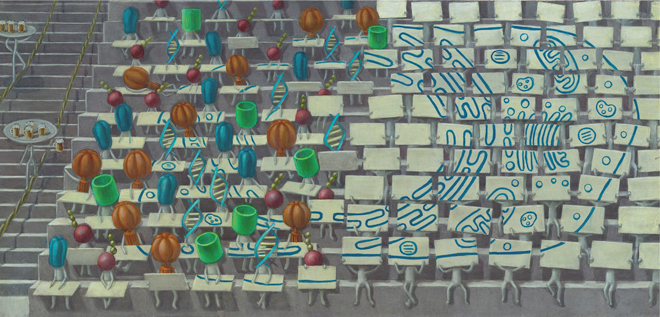
Spying minority in biological phenomena
A Grant-in-Aid for Scientific Research on Innovative Areas, MEXT (2011-2016)

NAGAI, Takeharu
Principal Investigator
Many cellular functions, such as transcription, signal transduction, and hormonal regulation, utilize limited number of molecules within a cell. Some transcription factors, for instance, exist at a maximum concentration of 0.1 nM, corresponding to only 10 molecules in a single nucleus of a eukaryotic cell. Despite the low numbers, these molecules can strictly regulate only two copies of the target gene. In the case of the intracellular signaling network, dozens of different proteins, each of which exist at a certain countable number, build up the entire network (Figure 1). Therefore, the stability and the behavior of such systems are very different from the ones reconstructed in a test tube, which are restricted to the Avogadro’s number of molecules. Our aim is to find a novel theory that will provide insights into such small systems in a living cell.
Technological breakthroughs in biophysics have made single molecules level studies possible. The advantage of single molecule studies is that no ensemble average is required. Single molecules are sensitive to the surrounding environment. The kinetic schemes can be mapped out and conformational dynamics can be probed directly without the ambiguity of homogeneous and inhomogeneous environments, which are generally encountered in bulk studies.
However, further technical advancements are required to reveal the elementary processes involved in the cooperative function/behavior among the low number of molecules within a living cell. We will investigate the following three aspects in this innovative area: i) new methodology and approaches to analyze the cooperative behavior among the small number of molecules, ii) cellular events regulated by a small number of molecules, and iii) model theories to integrate and explain the working of such small systems and networks.

Figure 1 Conceptual image of this innovative area. On the left side, molecules, such as F1ATPase, ribosome, ion channel, green fluorescent protein, and DNA, do not behave uniformly but individually (these molecules have been personalized and appear to be watching a baseball-game). On the right side, such individual molecules cooperate to form a “cell” image (similar to cheering their favorite team).